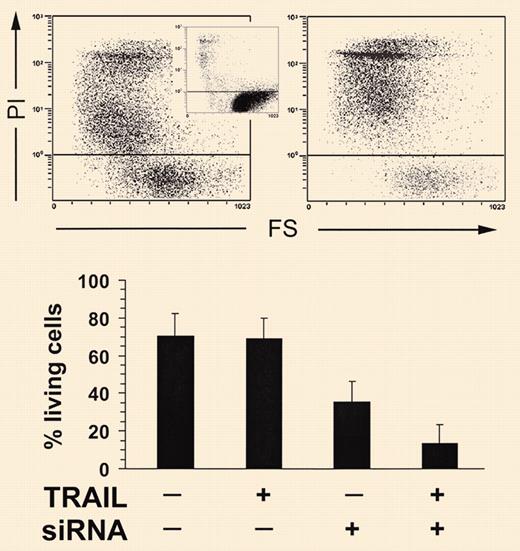Comment on Mirandola et al, page 2418
The importance of the report by Mirandola and colleagues is that the data may explain why natural killer (NK) and CD8+ T cells can survive despite liberating death receptor ligands and secretory granule contents.
This may be related to the phenomenon of the “veto” function of NK and CD8+ T cells (ie, elimination of precursors of cytotoxic T lymphocytes [CTLs]1-3 directed against these cytotoxic cells). They observe that activated human NK and CD8 T cells express TRAIL (tumor necrosis factor [TNF]–related apoptosis-inducing ligand) and TRAIL receptors but are not lysed by TRAIL. The primary mechanism of resistance to TRAIL is the expression of c-FLIP (cellular Fas-associated death domain protein [FADD]–like interleukin 1 [IL-1]–converting enzyme [FLICE]–inhibitory protein). The investigators observed that NK and CD8+ T cells expressed mRNA for the functional (R1 and R2) and decoy (R3 and R4) TRAIL receptors. TRAILR4 was expressed on the cell surface of resting and activated NK and CD8+ T cells, whereas R2 was expressed only after activation with cytokines. R1 and R3 were not expressed on the cell surface and this was associated with less mRNA. Soluble TRAIL induced apoptosis of control Jurkat and HL60 cell lines, which was blocked by TRAIL-R1 and -R2-Fc chimera molecules. However, resting control or activated NK and CD8+ T cells were resistant to additional apoptosis over the background levels. Treatment of both NK and T cells with actinomycin D to prevent new protein synthesis rendered them sensitive to TRAIL-induced apoptosis. The major protein that provided protection was c-FLIP because transfection of NK or T cells with siRNA specific for c-FLIP mRNA abrogated the resistance to TRAIL.FIG1
TRAIL-induced apoptosis of IL-2–activated NK cells (10 days) in the presence of anti-FLIP siRNAs. See the complete figure in the article beginning on page 2418.
TRAIL-induced apoptosis of IL-2–activated NK cells (10 days) in the presence of anti-FLIP siRNAs. See the complete figure in the article beginning on page 2418.
A significant feature of TRAIL is its selective destruction of tumor cells, sparing most normal cells.4 It will therefore be important to determine if some normal or tumor cells not lysed by TRAIL express TRAIL receptor R1 or R2 but are protected by the same or similar mechanism described in this report. ▪



